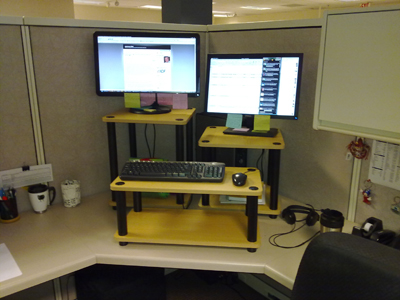This week was my first week trying the stand-up desk concept. While I had read of many people converting their office, I’m going to be reporting directly from the trenches, after spending a week in a cubicle with a stand-up desk and a list of architecture and development tasks that kept me tied to my desk, all day, every day.
The Desk
The last few months I have seen several posts about stand-up desks, with Ron Pereira showing his new setup, Kevin Mayer discussing accessorizing his work area, and Jon Miller taking the concept on the road. The thought intrigued me, but I wasn’t sure how I could implement it in a cubicle environment.
My three requirements were ease of implementation, ease of modification, and low initial investment. I considered stacking boxes, raising the brackets holding the desk, and even looked at purpose-built desks, but none of these options satisfied my requirements. After thinking about it a couple weeks, I decided to invest in some build-your-own shelving products from the local Lowes. I had previously used some custom shelving components to build a dual-computer platform for my home office, but I couldn’t recall what the expense had been. For about $30 I purchased 4 16″x16″ platforms, 2 12″x24″ platforms, and several lengths of connecting rods. This gave me enough materials to build the platforms for my desk, with several extra lengths of connecting rod for flexibility in the design process. An extra benefit was that the pieces could be reconfigured to provide additional shelving at home if the standing concept fell through.

My Standing Desk, v1.0
The First Week
Before the first day was out, I realized I was feeling more energized and engaged in my tasks. The feeling of standing was keeping me sharper and more focused on the tasks at hand, in a way I had rarely felt while sitting down. The standing desk caught people’s attention early and many of them took a few minutes to come by and ask about it, but even the higher-than-average number interruptions did not seem to derail me the way they did while I was sitting.
The first issue that came up was that I had underestimated the height of the keyboard. Also, while I had initially thought it would be difficult to judge the height of the monitors, it took me less than an hour to decide the taller monitor felt more comfortable. On Tuesday I brought in some more lengths of connecting rod and re-arranged the platforms.

My Standing Desk, v1.1
Unfortunately I also wore my favorite, though less comfortable, shoes on Tuesday. I learned the difficult lesson that my feet were not as accustomed to sustained standing as they had been when I was younger. For the remainder of the week I borrowed a tall directors chair, allowing me to sit every few hours, and wore my oxfords.
Why a Stand-up Desk?
My initial reasons for trying the stand-up desk were to (hopefully) increase my metabolic rate a little, decrease my sitting-related health risks, strengthen my core and back muscles, and test the claims of improved productivity and creativity. While I can’t speak to the medical or metabolic points, I can say that the claims of increased focus are true, and that I had muscle soreness early in the week that spoke to getting worked in a way it wasn’t accustomed to. Walking up to my desk is like turning a switch, I’m on task and ready to go.
So far there aren’t many cons to the setup. I still need to find a way to keep my coffee closer to hand (opportunity) and I hope that my feet will continue to acclimate to the standing so I don’t have to give up my favorite pair of shoes.
Next Week?
Perhaps the oddest feeling is that, while I have only been doing this a week, I am already convinced that I couldn’t go back to sitting all day. Whether this stems from some subconscious agreement that standing is a better working method for me or if it’s simply because I don’t want to carry all of those desk parts back down three stories, it looks like I will be standing for a while longer.
Continued the following year with a more permanent desk




 My roles have included accidental DBA, lone developer, systems architect, team lead, VP of Engineering, and general troublemaker. On the technical front I work in web development, distributed systems, test automation, and devop-sy areas like delivery pipelines and integration of all the auditable things.
My roles have included accidental DBA, lone developer, systems architect, team lead, VP of Engineering, and general troublemaker. On the technical front I work in web development, distributed systems, test automation, and devop-sy areas like delivery pipelines and integration of all the auditable things.

